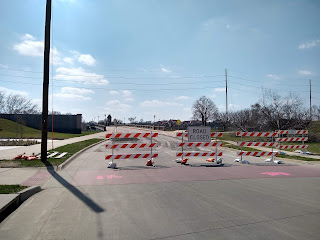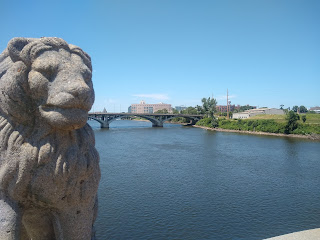 |
| July 22, 2022: cutting the ribbon on the Czech Village side |
City officials, business owners, and neighbors gathered last week to celebrate the reopening of the Bridge of Lions over the Cedar River, which connects the New Bohemia and Czech Village neighborhoods via 16th Avenue South. It was closed for nearly a year while flood protections were added on both sides of the river. Just this month, the cherry was added to the sundae in the form of gateway arches on each end of the bridge.
 |
| Entrance to Czech Village, July 11, 2022 |
The arches tell you the name of the neighborhood as you enter. The reverse side of the Czech Village arch says "Gateway to New Bohemia," and the reverse side of the New Bohemia arch says "Gateway to Czech Village." That should settle that, in a way that only a quality branding operation can do.
The speeches ahead of last week's ribbon cutting focused on the flood protection rather than the arches. Gates on each end of the bridge are on rollers which can roll across the road to connect to the flood wall on the other side. They are 14 feet high, providing protection to the volume of the catastrophic 2008 Cedar River flood. For the record, the gates are 67 feet long, four and a half feet thick, and weight 61,200 pounds.
 |
| Roller gate on the New Bohemia side, as seen from the street |
The total cost was $12 million, paid by the U.S. Army Corps of Engineers. The Corps in 2018 reversed their earlier decision not to fund flood protection on the west side of the river, possibly because a Republican administration was concerned about a vulnerable Republican member of the U.S. House, but that need not detain us here.
 |
| April 2020: Bridge closed |
 |
| May 2020: Construction begins |
 |
| July 2020: Construction continues |
Speakers included Mayor Tiffany O'Donnell...
 |
| Mayor O'Donnell addresses the gathering |
as well as City Manager Jeff Pomeranz from the City of Cedar Rapids, Lt. Col. John M. Fernas from the U.S. Army Corps of Engineers, and Monica Vernon, Director of the Czech Village/New Bohemia Main Street District.
 |
| Czech Village queen, prince and princesses. One of the princesses had to be rushed to the hospital with heat prostration |
Ribbons were cut on both ends of the bridge, for symmetry's sake....
 |
| New Bohemia side |
Assuming the increased flow of dollars to be inevitable, the future depends upon what kind of investment comes. Will the current dominance of locally-owned businesses continue, or will chains move in? That matters to how much money stays in the community. Will bars, restaurants, and shops continue to cater to occasional shoppers from outside the neighborhood ("drive-to urbanism"), or will there be places for residents to satisfy everyday needs? Housing construction is underway in New Bohemia, and is planned for Czech Village and the New Bo Extension, so we can hope for a critical mass of local residents, but as Oak Hill Jackson Neighborhood Association president Dorothy De Souza Guerdes points out, nothing has resulted from construction so far.
 |
| Loftus Lumber site in New Bohemia: City is trying to juice some mixed-use construction |
2. Connection. Growth in the District is likely to affect adjacent neighborhoods, Oak Hill Jackson on the New Bohemia side and Hayes Park on the west side. These connections are not certain to happen--at present the District and its neighbors are leading rather parallel lives--but as activity and especially population increase there's bound to be some spillover.
Increased investment in historically underserved neighborhoods is known by the snarl word gentrification. But neighborhood investment surely is desirable, because areas of concentrated poverty are bad for everyone but particularly the residents. Yet it comes, infamously, with risk of widespread displacement of current residents. Growth that includes and provides opportunities for current residents is good. Growth that pushes current residents aside so well-off newcomers can take advantage of the primo location is not good, and where done with public funding is outright scandalous. This could go either way in coming years.
 |
| Oak Hill Jackson has a lot of older housing as well as post-flood construction |
3. Broader social impacts. I'm in no position to measure the return-on-investment for the federal funds. Some level of benefit is highly likely, but in these inflationary days, we are surely aware that the government can't fund every good thing. What are the opportunity costs of putting their money into Cedar Rapids? Don't know. Can't say.
From the town's perspective, dense development near the center of town saves on infrastructure construction and maintenance costs, and makes efficient public transportation service possible. Should the school district follow the movement of people into the core, they could save on bus expenses because students around Czech Village and New Bohemia would be within walking distance of their school(s).
The environmental impact of development in the District depends on how many short car trips can be replaced by walking or cycling. Not only has the city just passed a climate action plan, but the world has had enough signs of climate change this summer to alarm all but the hardest-core denialists. A residential population walking to nearby stores would have a substantial positive impact on the environment, not to mention their own physical fitness. Conversely, if the District continues to rely on "drive-to" urbanism, while residents drive out of the neighborhood to get groceries and go to school and work, we'll continue to contribute to environmental degradation, including the possibility of future flooding.
 |
| Memorial to "the mayor of 2nd Street" in New Bohemia |
Change is inevitable; as Addison Del Maestro writes: We owe it to ourselves and to the future to keep building where we live, to keep iterating, to see people as a resource, and to see growth not like cancer but like childbirth: something painful and beautiful at the same time, something that takes away some things while opening up many more. The development that's about to happen can and should do honor to those like Edward Kuba whose visions built the neighborhoods.
What has been happening in Czech Village and particularly in New Bohemia doesn't look like "iterating," or course. To be sure our hands were forced by the flood and the need to forestall future floods. But it's good to remember that good change happens incrementally rather than relying on big wins and "game-changers." And that good change is inclusive, not a scrum where only the strong survive. The city can't dictate how change will roll out, but neither can it sit back and assume good change will happen automatically.
Let's continue to celebrate the efforts that have brought the District back. A lot of people worked really really hard to get us here. What happens next will make all the difference.
 |
| One of the lions overlooks his river |
NOTE: The Czech Village/New Bohemia Action Plan contains a vast array of concepts, which roughly divide between placemaking (wayfinding, parks, streets and other amenities) and housing. Of particular interest to this discussion:
- The Greenway Park (p. 53), a large multi-purpose park southeast of Czech Village and potentially easy to access by surrounding neighborhoods across C Street SW
- The Community Arts Trail (p. 66), a pedestrian/bike walkway on the south side of 10th Avenue from the river past the Cherry Building to 6th Street, highlighted by public art installations.
- Infill housing (pp. 69ff.) in both Czech Village and New Bohemia as well as the New Bo Extension, anticipated once the various amenities are in place, and which "would bring a wide range of prospective residents and visitors into the districts."
SEE ALSO:
"More New, Less Bo?" 4 July 2022
"The Future of Downtown Cedar Rapids," 24 June 2022
"Where Are the Metro's Destinations Heading?" 28 July 2021
"Bridging the Bridge," 26 June 2019




No comments:
Post a Comment